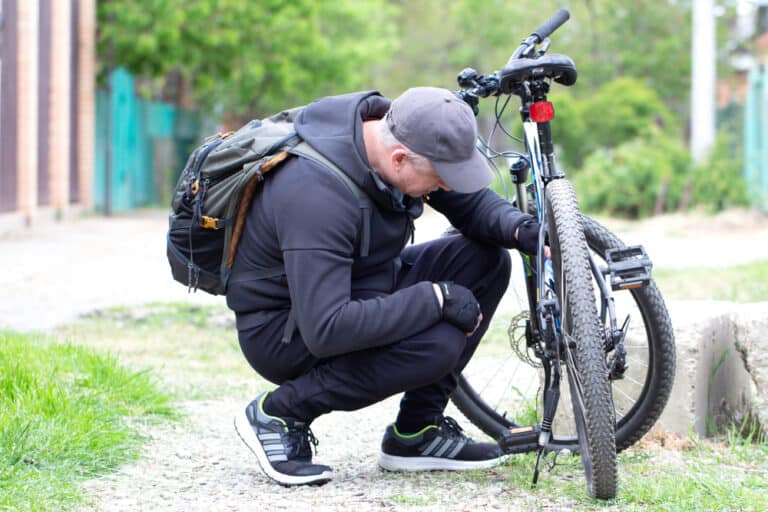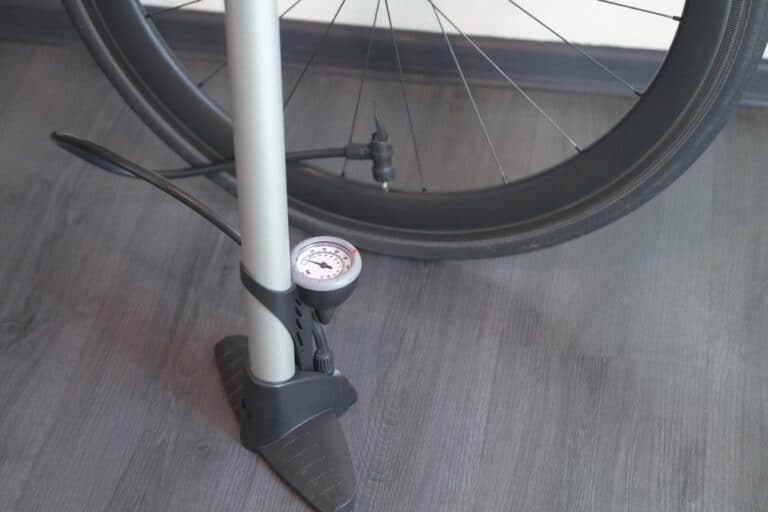Is Biking Cardio?

Cycling has never been more popular. More and more people worldwide are hopping onto their bikes to unwind or as an earth-friendly way to get around. Biking can be a relaxing way to get from place to place, and – bonus! – it’s also exercise. You likely feel your muscles working hard during an epic cycling session, but does your heart get a good workout too? Is biking cardio?
Biking is cardio exercise because it elevates your heart rate, raises your body temperature, speeds up your breathing, and improves your circulation. It can be low-, moderate- or high-intensity cardio, depending on whether you ride on flat or inclined ground and how fast you pedal.
So, biking is cardio. But how good is it at conditioning your heart, lungs, and circulatory system? Is it just a fun activity with minor cardio perks, or can it give you full benefits like improved fitness, disease prevention, and weight loss? And are there ways to cycle to maximize your cardio gains? I know the answers and am about to share them with you!
Is Biking Cardio Exercise?
Not only is biking cardio; it’s one of the top cardio exercises.
But don’t take my word for it.
Let’s look at the criteria for cardio exercise and check whether biking meets (or perhaps even crushes!) them.
#1: Cardio Uses Oxygen
Cardio is different from other types of exercise (strength and flexibility) because its success depends on how well your body uses oxygen. That’s why it’s also called aerobic (with oxygen) exercise.
The better your body is at inhaling oxygen and getting it where it’s needed, the easier it is to do cardio exercise. Your ability to use oxygen to power your cardio workouts is called your cardio capacity. This is influenced by genes, sex (women’s capacity is typically lower), and age (your capacity generally decreases as you get older).
Does Biking Use Oxygen?
Yup, cycling needs a steady supply of oxygen. And whether you breeze or huff and puff through biking workouts is down to your ability to use the oxygen efficiently or your cardio capacity.
#2: Cardio Makes You Breathe More
Your increased need for oxygen while doing cardio makes you breathe faster and deeper.
With time, regular cardio exercise strengthens your respiratory system (your lungs, airways, and blood vessels) and increases your cardio capacity.
Does Biking Make You Breathe More?
You’ll need to take more frequent and deeper breaths while biking, as plenty of O2 is essential to cycling.
The harder you make your body work, the more oxygen you’ll need to inhale to power your muscles, so they can keep peddling!
#3: Cardio Ups Your Heart Rate
Cardio’s defining characteristic is that it makes your ticker beat faster.
The more effort you put into your cardio workout, the faster your heartbeat. You can push yourself a little or go all out while doing cardio to ace different body goals, like getting fitter, conditioning your heart and lungs, improving your endurance, and burning calories and fat.
High-intensity cardio makes your body work hardest. Think: racing heart, heavy sweating, and fast breathing. It’s tough! Your heart beats between 70 and 85% of its maximum heart rate per minute (work this out by subtracting your age from 220). This type of cardio is best for improving your fitness and scorching calories.
Moderate-intensity cardio gets your heart rate to about 50 to 70% of its max. This type of cardio feels manageable and gives you countless health and fitness benefits.
Low-intensity cardio raises your heart rate to below 50% of its max. Although this type of cardio doesn’t boast all the benefits of more intense exercise, it still does your whole body good! Plus, it’s a super pick for warm-ups before more intense exercise.
You might have heard fitness fans talk about a target heart rate. This is between 50 and 85% of your maximum heart rate, and this many beats per minute will give you the most rewards.
Don’t have the energy for the mental workout it will take to calculate how fast your heart should be beating? No problem! Here’s a glance at maximum heart rates and target heart rate ranges for people of different ages:
| Age | Average Maximum Heart Rate (beats per minute) | Target Heart Rate Range (beats per minute) |
| 20 | 200 | 100 to 170 |
| 30 | 190 | 95 to 162 |
| 40 | 180 | 90 to 153 |
| 50 | 170 | 85 to 145 |
| 60 | 160 | 80 to 136 |
| 70 | 150 | 75 to 128 |
Does Biking Up Your Heart Rate?
It sure does! Don’t believe me? Get onto your bike and start peddling fast. Within seconds you should notice your heart rate pick up.
Biking can raise your heart rate a little or drastically depending on whether you do low-, moderate-, or high-intensity cycling.
You’d speed or cycle uphill (high intensity) to spike your heart rate or pedal leisurely (low intensity) for a slight increase, or you could choose a fast yet doable cycling pace (moderate intensity) to get your heart rate into the target zone.
The easy way to know what your heart is getting up to is to wear a heart rate monitor (like a fitness watch). You can also get an idea of how fast your heart is beating by tuning in to what your body tells you while you cycle.
These are signs you’re exercising at a low intensity:
- The exercise feels easy.
- You could belt out a song.
Here are clues that you’re doing moderate-intensity exercise:
- The exercise feels difficult but manageable.
- You’re breathing fast but aren’t breathless.
- You break a bit of a sweat after about 10 minutes.
- You can chat but would struggle to sing (especially an emotionally charged ballad!).
You’re likely working out at a high intensity if you experience these signs:
- The exercise feels tough.
- You’re breathing fast and deeply.
- You break a sweat within minutes.
- You can’t say a whole sentence without pausing to breathe.
…Biking also makes your heart rate slower. At rest, that is. This is a good thing, as it’s a sign of fitness. So, cycling (and all other cardio) has double benefits for your heart: speeding it during exercise and then slowing it at rest.
#4: Cardio Boosts Your Heart Health
Cardio makes your heart healthier in various ways. It makes it stronger so it can pump blood around your body more easily, improves circulation, and lowers high blood pressure.
Does Biking Boost Your Heart Health?
Absolutely! Multiple studies back this up.
Researchers keep finding evidence to support cycling’s heart-enhancing benefits, including improved heart function, protection against heart disease, and lowered blood fat levels.
#5: Cardio Burns Calories
Cardio’s health and fitness benefits are great, but it’s all about the calorie burn for many of us!
Put enough oomph into your cardio exercise, and you can fire up your metabolism and scorch calories.
Does Biking Burn Calories?
You bet! Biking is one of the best calorie-burners, as it can get your heart thumping and challenges many large muscle groups (I’m talking about glutes, quads, hamstrings, and calves).
Your calorie-burn while cycling depends on your weight (the more you weigh, the more calories you burn), muscle mass (the leaner you are, the higher your calorie-burn), your exercise intensity (you burn more calories when working out at higher intensities), and exercise duration (a longer session lets you clock up a greater calorie-burn).
Here’s an idea of how many calories people of different weights can burn while cycling for 30 minutes at moderate or high intensity:
| Weight (pounds) | Calories burnt cycling at 12 to 13.9 miles per hour (moderate intensity) | Calories burnt cycling at 14 to 15.9 miles per hour (high intensity) |
| 120 | 218 | 273 |
| 130 | 236 | 295 |
| 140 | 255 | 318 |
| 150 | 273 | 341 |
| 160 | 291 | 364 |
| 170 | 309 | 386 |
| 180 | 327 | 409 |
| 190 | 345 | 432 |
| 200 | 364 | 455 |
Is Biking A Good Cardio Workout?
Biking is a cardio superstar!
Cycling can give you full cardio benefits, whether you’re new to exercise or a pro. Stick to flat roads and shorter distances if you’re starting and want to take it easy, or try mountain biking or marathons for something more challenging.
Cycling can make your heart, lungs, and circulation work better, help you lose weight, burn fat, and get fitter. Wins all around!
One of cycling’s most impressive claims to fame is that it can give you a heart-strengthening, sweaty, calorie-torching workout without stressing your joints. Many other exercises powerful enough to offer all these cardio gains, like running, are high-impact and can be hard on the knees and ankles.

Conclusion
Biking meets all the cardio criteria: it uses oxygen, makes you breathe more, ups your heart rate, boosts your heart health, and burns calories. So, biking is undeniably cardio exercise.
Not only is biking cardio, but it’s a cardio hero capable of helping people with different fitness levels reach multiple health and fitness goals. Plus, it’s low impact, so it does all these marvelous things for your body with lower injury risk. And it’s fun! C’mon, get peddling!
References
- https://www.healthline.com/health/fitness-exercise/aerobic-exercise-examples#bottom-line
- https://www.medicalnewstoday.com/articles/what-exercise-burns-the-most-calories
- https://www.mayoclinic.org/healthy-lifestyle/fitness/in-depth/exercise-intensity/art-20046887
- https://www.webmd.com/fitness-exercise/a-z/biking-workout
- https://www.healthline.com/health/fitness-exercise/cycling-benefits#drawbacks-and-safety
- https://www.healthline.com/health/fitness-exercise/cycling-vs-running#more-considerations
- https://www.medicalnewstoday.com/articles/benefits-of-cycling
- https://www.verywellfit.com/everything-you-need-to-know-about-cardio-1229553
- https://www.healthline.com/health/fitness-exercise/cardio-exercises-list#Why-Do-You-Need-Cardio-in-the-First-Place?
- https://my.clevelandclinic.org/health/articles/7050-aerobic-exercise
- https://www.betterhealth.vic.gov.au/health/healthyliving/cycling-health-benefits
- https://www.healthline.com/health/dangerous-heart-rate#what-increases-heart-rate
- https://caloriecontrol.org/healthy-weight-tool-kit/get-moving-calculator/






